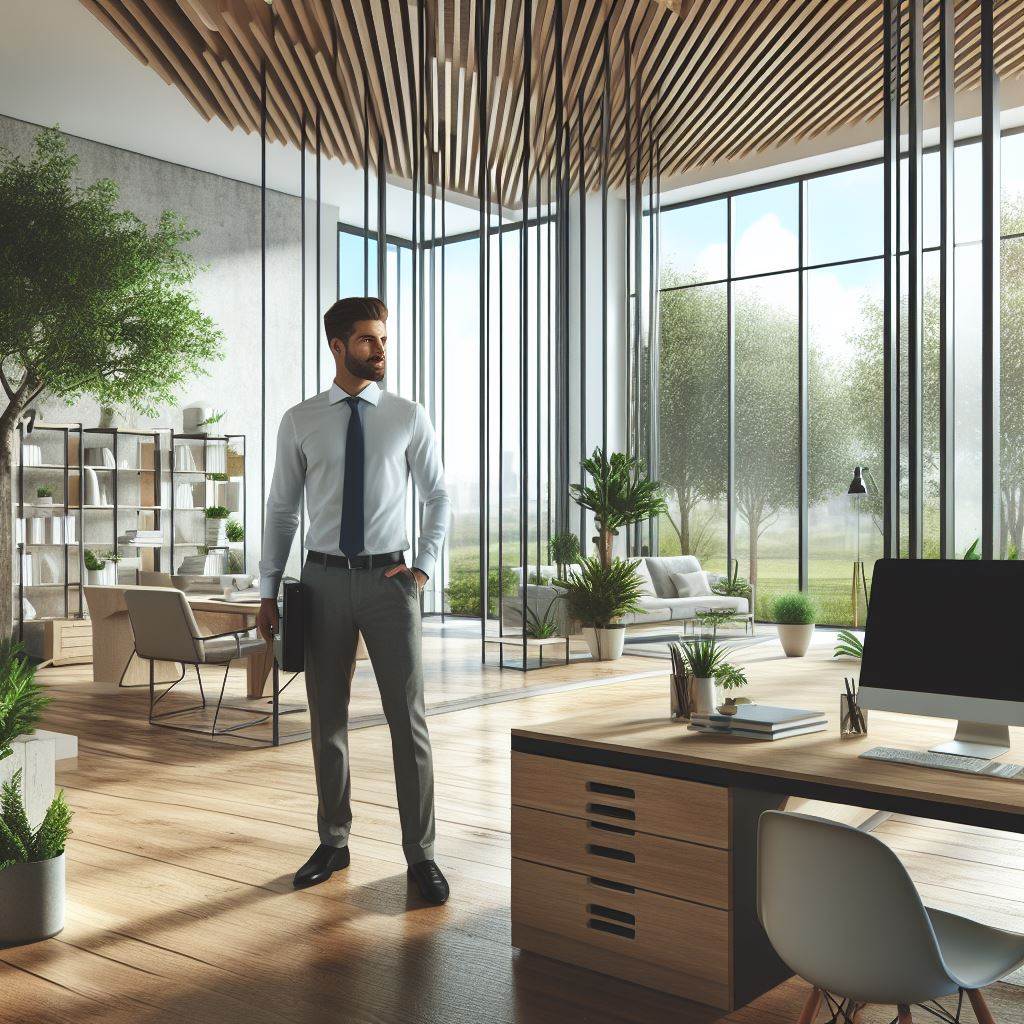Introduction
The US office space market is a dynamic sector with significant economic implications.
Analyzing the trends and outlook for 2024 allows us to understand future opportunities and challenges.
The US office space market is a vital part of the country’s economy, encompassing various industries and sectors.
It includes commercial office buildings, co-working spaces, and flexible workspaces.
Analyzing the 2024 trends and outlook helps businesses and investors make informed decisions.
It showcases potential growth areas, market demand, and emerging technologies that can impact the office space market.
By evaluating the trends, we can determine if there is a shift towards remote work, increasing demand for flexible workspaces, or the need for sustainability initiatives.
This analysis offers insights into the changing work environment and evolving preferences.
Understanding the future outlook aids real estate developers, brokers, and landlords in strategizing.
It helps them adapt their offerings to meet the evolving demands of tenants and maintain a competitive edge in the market.
Additionally, it enables companies to align their office space requirements with future growth plans effectively.
Furthermore, identifying emerging trends and technologies allows investors to explore opportunities to invest in innovative office space solutions.
This analysis can foster economic growth, job creation, and enhance productivity in the office space sector.
In fact, analyzing the 2024 trends and outlook of the US office space market is essential for understanding its dynamics, shaping strategies, and capitalizing on future opportunities.
It offers valuable insights into the industry’s trajectory and enables stakeholders to adapt and thrive in a rapidly changing business landscape.
Transform Your Real Estate Decisions
Unlock personalized real estate insights crafted just for you. Get actionable advice designed to amplify your success.
Get StartedCurrent State of the US Office Space Market
The US Office Space Market has undergone significant transformations in recent years, shaped by various factors ranging from economic shifts to the unprecedented challenges posed by the COVID-19 pandemic.
This section delves into the intricate details of the market’s current landscape.
Overview of the office space market in recent years
In recent years, the US office space market has witnessed a dynamic evolution marked by changing preferences in workspace design.
The trend toward flexible and collaborative environments gained momentum as businesses sought to foster innovation and adapt to the evolving needs of the workforce.
Key statistics and performance indicators
Key statistical indicators reflect the resilience of the market amidst challenges.
Despite uncertainties, the market demonstrated robustness in certain segments, with a noticeable surge in demand for flexible office spaces.
Co-working spaces, in particular, emerged as a focal point, offering businesses agility and cost-effectiveness.
Impact of the COVID-19 pandemic on the market
The COVID-19 pandemic brought about a paradigm shift in how businesses perceive and utilize office spaces.
Remote work became the norm, prompting a reevaluation of traditional office setups.
While some companies adopted a hybrid approach, others embraced fully remote models.
This shift resulted in a temporary decline in demand for physical office spaces, prompting landlords and property managers to innovate and adapt to the new normal.
Analysis of demand and occupancy rates
Demand and occupancy rates experienced fluctuations as businesses navigated the uncertainties of the pandemic.
The rise of remote work led to a temporary dip in demand for traditional office spaces, especially in urban centers.
However, as the economy rebounded, a resurgence in demand was observed, albeit with a preference for flexible leases and adaptable spaces.
Showcase Your Real Estate Business
Publish your company profile on our blog for just $200. Gain instant exposure and connect with a dedicated audience of real estate professionals and enthusiasts.
Publish Your ProfileRental and vacancy trends
Rental trends reflected the evolving dynamics of the market.
Landlords, responding to the changing landscape, introduced more flexible leasing options.
Vacancy rates, while initially elevated, stabilized as businesses recalibrated their office space requirements.
The market responded with innovative solutions, such as reconfigurable spaces and tech-enabled amenities, to meet the evolving needs of tenants.
In short, the current state of the US office space market reflects a landscape in flux, adapting to the challenges and opportunities presented by recent global events.
Businesses and property stakeholders alike are navigating this transformative period, shaping the future of workspaces in innovative and flexible ways.
Read: Mixed-Use Properties: Pros & Cons
Emerging Trends in the US Office Space Market
Remote work and its influence on office space requirements
Remote work has gained significant momentum, with companies realizing the benefits of a virtual workforce.
As more employees work from home, the demand for traditional office spaces has decreased.
Companies are reevaluating their office space requirements, downsizing or opting for flexible lease agreements.
Reimagining office space design and layout
Traditional cubicles are being replaced with open-plan layouts that promote collaboration and innovation.
Designers are integrating ergonomic furniture, natural lighting, and green plants to create a more comfortable work environment.
Office spaces are now being designed to adapt to different work styles and preferences.
Increasing importance of flexible and co-working spaces
Flexible workspaces and co-working spaces have gained popularity due to their cost-effectiveness and flexibility.
Companies are opting for shared spaces, allowing them to decrease overhead costs and easily scale up or down.
Co-working spaces also foster networking opportunities and collaboration among professionals from different industries.
Sustainable and eco-friendly office spaces
Businesses are increasingly considering sustainable practices when designing and choosing office spaces.
Green buildings with energy-efficient features and renewable energy sources are becoming more prevalent.
Companies are embracing eco-friendly practices such as recycling, reducing waste, and promoting sustainable transportation options.
Tech advancements shaping the office space market
Technological advancements have revolutionized office spaces, incorporating automation, AI, and virtual reality.
Smart office systems enable efficient energy management, improved security, and personalized employee experiences.
Virtual meeting platforms and remote collaboration tools have become essential for remote and hybrid work models.
Adoption of hybrid work models
The COVID-19 pandemic has accelerated the adoption of hybrid work models combining remote and in-office work.
Companies are redesigning their office spaces to accommodate a flexible workforce that switches between remote and on-site work.
Hybrid models provide employees with increased work-life balance and allow companies to attract and retain top talent.
The US office space market is evolving rapidly, driven by emerging trends such as remote work, flexible spaces, and sustainability.
Companies are recognizing the need to adapt their office spaces to meet the changing demands and preferences of employees.
By embracing these trends, businesses can create more productive, engaging, and environmentally friendly work environments for their employees.
Read: Office Design Trends in 2024

Factors Driving Office Space Market Growth
The dynamic landscape of the US office space market in 2024 is shaped by a myriad of factors, each playing a crucial role in influencing its trajectory.
Showcase Your Real Estate Business
Publish your company profile on our blog for just $200. Gain instant exposure and connect with a dedicated audience of real estate professionals and enthusiasts.
Publish Your ProfileThis section delves into the key drivers propelling the market’s growth.
Economic factors and GDP growth projections
The symbiotic relationship between the economy and the office space market is more pronounced than ever.
As the US economy continues its recovery, GDP growth projections become a compass for real estate trends.
Investors and businesses keenly monitor economic indicators, making strategic decisions aligned with the anticipated economic upswing.
The surge in GDP translates into increased demand for office spaces, reflecting a growing confidence in business expansion.
Industry-specific demands and expansions
The diversification of industries across the United States has a profound impact on the office space market.
Tech hubs witness a surge in demand for innovative workspaces, while traditional sectors may require more conventional setups.
As industries evolve, so do their spatial needs.
Understanding these nuanced demands becomes imperative for stakeholders in the office space market to adapt and cater to the evolving preferences of businesses.
Urbanization and migration patterns
The allure of urban environments remains a pivotal factor in shaping office space demands.
Urbanization and migration patterns play a crucial role in determining where businesses choose to establish their presence.
Emerging trends showcase a preference for mixed-use developments that integrate work, living, and recreational spaces.
Understanding the ebb and flow of urbanization aids in predicting regional office space requirements.
Job market trends and employment growth
A robust job market fuels the demand for office spaces, serving as a barometer for market vitality.
Employment growth directly correlates with the need for workspaces, as expanding businesses seek to accommodate their growing workforce.
The evolving nature of work, including remote and hybrid models, further underscores the importance of flexible and adaptable office spaces.
Investor interest in commercial real estate
Investors continue to show unwavering interest in commercial real estate, attracted by the potential for long-term gains.
As the office space market undergoes transformations, investors closely scrutinize emerging trends, technological advancements, and sustainable practices.
The convergence of investor interest and market innovation is a catalyst for reshaping the office space landscape.
In summary, the multifaceted growth of the US office space market in 2024 is intricately tied to economic, industry-specific, urbanization, job market, and investor-driven factors.
Understanding and navigating this complex interplay is essential for industry players seeking to thrive in an ever-evolving market.
Read: Future of Retail: Malls vs Online
Regional Outlook for US Office Space Market
As we navigate through the dynamic landscape of the 2024 US Office Space Market, it’s imperative to delve into the regional nuances that shape the industry’s trajectory.
This section explores key facets, ranging from major metropolitan areas to burgeoning business hubs, offering a comprehensive analysis of the nation’s diverse office space market.
Analysis of Major Metropolitan Areas and Business Hubs
The heartbeat of the US office space market resonates in its major metropolitan areas and bustling business hubs.
Cities like New York, San Francisco, and Chicago continue to dominate, showcasing resilient demand driven by a confluence of factors – from tech innovation to financial prowess.
These metropolises embody the evolution of workspace dynamics, integrating flexible solutions to meet the demands of modern businesses.
In contrast, emerging business hubs like Austin and Denver are experiencing a paradigm shift.
Fueled by a combination of lifestyle preferences and economic incentives, these cities are carving a niche as attractive alternatives for businesses seeking agility and adaptability.
Comparison of Regional Market Performance
Regional disparities in market performance are evident, each area displaying its unique characteristics.
Showcase Your Real Estate Business
Publish your company profile on our blog for just $200. Gain instant exposure and connect with a dedicated audience of real estate professionals and enthusiasts.
Publish Your ProfileThe East Coast’s steady growth mirrors a commitment to traditional business values, with a focus on stability and established infrastructure.
The West Coast, on the other hand, remains a hotbed for innovation, driving demand for flexible and collaborative spaces.
The heartland, characterized by cities like Dallas and Minneapolis, is witnessing a renaissance, as companies seek cost-effective solutions without compromising on quality.
Understanding these regional intricacies is vital for investors and businesses alike, as they navigate the diverse landscapes of the US office space market.
High-Growth Markets and Emerging Cities
Identifying high-growth markets and emerging cities is pivotal for staying ahead of the curve.
Cities such as Nashville and Raleigh are experiencing a surge in demand, fueled by a combination of affordability, quality of life, and a burgeoning tech scene.
These markets present exciting opportunities for businesses looking to capitalize on the next wave of growth.
All in all, the 2024 US Office Space Market is a tapestry woven with diverse regional threads.
Navigating this landscape requires a nuanced understanding of each area’s unique dynamics, from established metropolises to the rising stars on the horizon.
Stay tuned as we delve deeper into these regional trends and explore the intricate dance between demand, innovation, and regional identity shaping the future of office spaces across the United States.
Read: E-Commerce & Warehouse Spaces
Challenges and Opportunities in the US Office Space Market
Addressing the Excess Supply of Office Space
The US office space market is currently facing a formidable challenge: an excess supply of commercial real estate.
With the rise of remote work trends, many businesses are reevaluating their office space needs.
To address this surplus, property owners and developers must innovate.
Converting traditional office spaces into flexible work hubs or multifunctional facilities can breathe new life into underutilized properties.
Collaborative efforts between landlords and businesses can lead to creative solutions, transforming the surplus into an asset.
Adapting to Remote Work Dynamics and Changing Needs
The paradigm shift towards remote work has transformed the very fabric of the office space market.
To thrive in this evolving landscape, businesses must adapt.
This involves redesigning office layouts to foster collaboration during in-person meetings while maintaining flexibility for remote work.
Technological integration becomes paramount, ensuring seamless connectivity between physical and virtual spaces.
Companies that embrace hybrid models, offering both remote and in-person work options, stand to gain a competitive edge in attracting and retaining top talent.
Navigating the Post-Pandemic Recovery Period
The aftermath of the pandemic presents both challenges and opportunities for the US office space market.
The recovery period demands a careful balance between caution and innovation.
Property owners need to implement health and safety measures to instill confidence in returning employees while exploring strategies to repurpose existing spaces for emerging needs.
The emphasis on employee well-being and creating environments conducive to productivity becomes a pivotal factor in the recovery journey.
Identifying Investment and Development Opportunities
Amidst challenges, opportunities emerge for astute investors and developers.
The demand for flexible workspaces, technology-driven solutions, and sustainable design opens avenues for strategic investments.
Adaptive reuse of existing office spaces for residential or mixed-use developments can unlock hidden potential.
Collaborations with proptech firms can lead to the creation of smart office spaces that align with the evolving needs of businesses and the workforce.
Therefore, the US office space market of 2024 presents a landscape ripe with challenges and opportunities.
Showcase Your Real Estate Business
Publish your company profile on our blog for just $200. Gain instant exposure and connect with a dedicated audience of real estate professionals and enthusiasts.
Publish Your ProfileSuccessful navigation requires a proactive approach, embracing change, and leveraging innovative solutions to transform challenges into avenues for growth
Conclusion
The 2024 US office space market is expected to witness several noteworthy trends.
Firstly, there will be a growing preference for flexible office spaces, driven by the changing work styles and increasing demand for agility.
Secondly, technological advancements will play a crucial role in shaping the office space market, with businesses prioritizing the integration of smart technologies and automation.
Additionally, the market will experience a shift towards sustainable office spaces, as organizations emphasize eco-friendly practices and design.
Lastly, the rise of remote work and virtual offices will have a considerable impact on the demand for traditional office spaces.
There are significant opportunities in the 2024 US office space market for those who adapt to the emerging trends.
Providers of flexible office spaces can capitalize on the increasing demand, while technology companies can cater to the need for innovative solutions.
Developers focusing on sustainable office spaces will also find growth opportunities.
However, challenges such as intensified competition, the need for substantial investments in technology, and the requirement to meet evolving sustainability standards pose potential obstacles.
The future outlook for the US office space market appears promising.
As businesses continue to evolve, the demand for flexible, technologically advanced, and sustainable office spaces will persist.
By adapting to these trends and addressing the challenges, companies can position themselves for success in this dynamic market.
It is essential for industry players to stay agile, innovative, and environmentally conscious to meet the evolving needs of businesses and maintain long-term relevance in the office space market.




